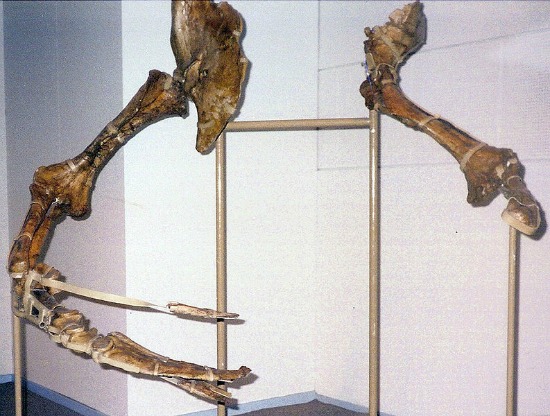What Prehistoric Reptile Do These Three-foot Claws Belong To?
Claws once thought to belong to a giant turtle turned out to be from one of the weirdest dinosaurs ever found
![]()

The arms of Therizinosaurus–as yet, the rest of the dinosaur is missing. Photo by FunkMonk, image from Wikipedia.
The most famous set of arms in the history of dinosaurs belong to Deinocheirus–eight foot long appendages from a huge ornithomimosaur that roamed Mongolia around 70 million years ago. But the immense ostrich-mimic wasn’t the only giant omnivore of its time, nor the only one made famous by its imposing arms. About 20 years before the discovery of Deinocheirus, a joint Soviet-Mongolian expedition found extremely long, tapering claws and a few other bones from a gigantic reptile. The identity of this animal took decades to untangle.
Paleontologist Evgeny Maleev described the paltry remains in a 1954 paper. Based on rib fragments, a bone from the hand, and three claws, Maleev believed that he was looking a gargantuan turtle. He named the creature Therizinosaurus cheloniformis–roughly, the “turtle-like scythe lizard.”
The animal’s claws played a key role in the identification. No terrestrial animal had such claws, he argued. Such armaments “may have been originally used by the animal for cutting aquatic vegetation or for another function, constrained by movement and acquiring food.” And even though Maleev only had pieces to work with, he proposed that Therizinosaurus was about 15 feet long with claws at least three feet long. This aquatic, apparently armor-less turtle lived in a time of hadrosaurs, tyrannosaurs, and sauropods.
Therizinosaurus wasn’t recognized as a dinosaur until 1970. In that year, paleontologist Anatoly Konstantinovich Rozhdestvensky published a re-evaluation of Maleev’s fossils that found the rib to be from a sauropod dinosaur, but the hand bone and the claws to be from some as-yet-unknown theropod. This recognition only spawned a new mystery–what sort of theropod dinosaur was Therizinosaurus, and what was the creature doing with such fearsome claws?
More complete forelimb and shoulder material described by Rinchen Barsbold in 1976 showed that Therizinosaurus had extraordinarily robust arms–quite a departure from the trend seen in large carnivorous dinosaurs, in which the arms seemed to become smaller as skulls became more heavily-built. At a time when theropod was generally considered to be synonymous with “carnivorous dinosaur”, it’s not surprising that experts speculated that Therizinosaurus was a monstrous predator who used claws, rather than teeth, to slice up the hadrosaurs and sauropods of its time. That’s the way I encountered the dinosaur in the books I read as a kid–a little-known, Cretaceous hadrosaur-shredder.
What researchers didn’t recognize was that Therizinosaurus represented an entirely new variety of theropod dinosaur. More complete skeletons of related forms such as Segnosaurus, Erlikosaurus, Alxasaurus, and Beipiaosaurus revealed the presence of a previously-unknown group of dinosaurs with long necks, beaked mouths, fat bodies, and stout arms tipped with ludicrously-long claws. These were omnivorous or herbivorous dinosaurs, not carnivores, although paleontologists didn’t immediately agree on what lineage they belonged to. Some thought they might be aberrant ornithischians–on the opposite side of the dinosaur family tree from theropods–or strange variations on the sauropod theme. By the mid-90s, however, paleontologists recognized that these truly were theropods, and ones belonging to the maniraptoran group that also encompasses the strange alvarezsaurs, beaked and crested oviraptorosaurs, the sickle-clawed deinonychosaurs, and birds. This group of tubby, feathery dinosaurs became known as the therizinosaurs.
Although Maleev didn’t recognize it when he named Therizinosaurus, he had found one of the most spectacular dinosaurs of all time–a giant, fluffy, omnivorous dinosaur that challenged what we thought we knew about theropods. Still, our image of Theriziniosaurus relies on the skeletons of more complete, closely-related dinosaurs. So far, we only really know what the arms of this dinosaur looked like, and the hindlimb elements described in the 1980s may or may not belong to another creature. We’re still waiting for the true nature of this undoubtedly bizarre dinosaur to come into focus.
References:
Barsbold, R. 1976. New data on Therizinosaurus (Therizinosauridae, Theropoda) . In Devâtkin, E.V. and N.M. Ânovskaâ (eds.), Paleontologiâ i biostratigrafiâ Mongolii. Trudy, Sovmestnaâ Sovetsko−Mongol’skaâ paleontologičeskaâ kspediciâ, 3: 76–92.
Maleev, E.A. 1954. “New turtle−like reptile in Mongolia .” Priroda, 1954, 3: 106–108.
Zanno, L. 2010. A taxonomic and phylogenetic re-evaluation of Therizinosauria (Dinosauria: Maniraptora). Journal of Systematic Palaeontology. 8, 4: 503–543.
/https://tf-cmsv2-smithsonianmag-media.s3.amazonaws.com/accounts/headshot/RileyBlack.png)
/https://tf-cmsv2-smithsonianmag-media.s3.amazonaws.com/accounts/headshot/RileyBlack.png)